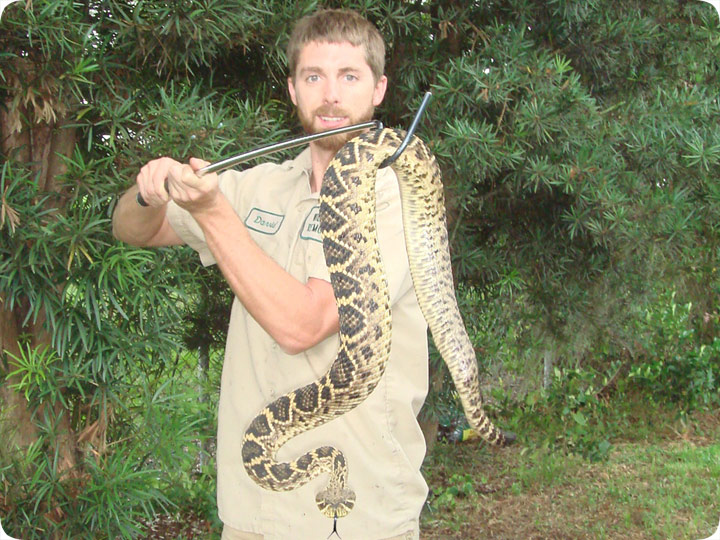-
info@aaanimalcontrol.com
Call us for help in your town
Humane Wildlife Education
Orlando Rattlesnake

08.24.2006 - Here's an Orlando Rattlesnake
With diamonds on its back
Please, dear reader, make no mistake
It has a most deadly attack
It's armed with hypodermic
fangs
And a nasty disposition
Upon my trusty hook it hangs
In a compromised position
But if you see it on the ground
And if you get too close
Soon, my friend,
you will have found
Yourself with a lethal dose
You may have seen the warning signs
The coiling and the rattle
Because before this serpent dines
Its tail begins
to tattle
Let that serve as ample warning
For you to back away
So you can wake tomorrow morning
To see another day
For if you decide to get in reach
To photo
it or catch it
This snake has a lesson to teach
And your defenses cannot match it
So if you come across this fellow
Simply don't go nearby
From a distance just
wave hello
Then politely say goodbye
I, on the other hand, as a trained nuisance wildlife removal specialist and snake handler in Orlando, when called upon to remove
such a snake from the playground of a school (of all places!) where it was lurking, and in possession of the correct equipment, including an extendable snake sack, am qualified
to handle this snake. There aren't many Orlando rattlesnakes. Most rattlers need undeveloped area in which to thrive. The pigmy rattler isn't lethal, but the
above snake, an Eastern Diamondback, most definitely is. One other thing about this snake - the rattle on the tail was broken off, so it could not give off its
traditional warning sound. But the appearance of this snake alone - fat, very wide head, and distinct diamonds on its back, should be enough for most people to suspect
that this is a do-not-touch variety of snake.
Do it yourself: Visit my How To Get Rid of Snakes page for tips and advice.
Get professional help: Visit my Nationwide Pro Directory of wildlife removal experts.
For more wildlife stories, click my Wildlife Blog
or click my below banner to hire a local trapper.
Appearance
There are many snakes in Orlando Florida. Perhaps one of the most famous being the eastern diamondback rattlesnake. The eastern diamondback rattlesnake lives mostly on the eastern shore of North America. These snakes are the largest among the pit viper family and can grow as large as eight feet long and weigh anywhere from eight to 12 pounds! Diamondbacks are easy to identify due to their black diamond scale pattern. They also have a distinctive rattle at the tip of their tails that make them stand out.
Biology
Diamondback rattlesnakes are among the pit viper family. Pit vipers have a small “pit” by their nostrils which they use to detect heat signatures. This is especially important because they use this ability to hunt their prey. Diamondbacks are commonly split between eastern and western. Eastern diamondbacks are the largest snakes in the pit viper family and are perhaps the most famous. They reside on the eastern shore of the U.S and normally grow between three to five feet long but can grow as long as eight feet long. Western diamondbacks are found on the east coast and can also be found in some southern states and in Mexico.
Behavior
Diamondback rattlesnakes are known to be strong swimmers. Despite their large size, they can swim very well. Smaller diamondback snakes can also climb bushes to hunt. These snakes are great hunters and can sense heat signatures which can make them very dangerous. Because the diamondback is a rattlesnake, they often rattle their tails, creating a rattle like sound when they sense danger. The rattle is a warning signal for potential hunters. This rattle sometimes is heard as far as thirty feet away from the snake. In the event you encounter this, slowly walk backward, and when far enough, the snake will stop rattling. While this is true, it is also important to know that when surprised or cornered, diamondbacks will strike without warning which can be fatal as they are very poisonous snakes.
Habitat
The diamondback rattlesnake prefers to be in a wooded habitat. This normally results in them being in the woods where there is plenty of ground cover, leaves, and other materials they can shelter in. These snakes are notorious for seeking shelter in other animals' spaces, especially during the winter. They are commonly found in the burrows of gophers and tortoises.
Diet
Diamondback rattlesnakes are natural hunters that have multiple prey targets. Because they are venomous snakes, they often bite their prey, relying on their venom to do most of the leg work. They will often quickly follow up with other vicious attacks to finish off their prey. While diamondbacks are known to commonly hunt rabbits, birds, mice, and other mammals, they will also hunt almost anything that comes in their way. Anything that they can kill is essentially food for these poisonous snakes.




















